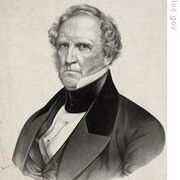
Winfield Scott of Indiana.
The Second Britannic Design, also known as the Second Design, was a series of proposed amendments to the Britannic Design of 1781 adopted at the Burgoyne Conference of 1842 and confirmed by the British Parliament. The Second Britannic Design transformed the Confederation of North America from a loose confederation of British colonies to a unified nation.
The first amendment adopted by the Burgoyne Conference altered the Grand Council from a body appointed by the legislatures of the various confederations to a popularly elected national legislature of 150 members serving five-year terms. The franchise for voting in Grand Council elections was originally limited to male landowners, but a series of reform bills passed between 1869 and 1898 widened the franchise to universal male suffrage, while the Reform Bill of 1908 extended the franchise to women. The first amendment also created a Confederation Senate consisting of five appointed members from each confederation, though the Senate had little actual power.
The second amendment adopted by the Burgoyne Conference revised the office of Governor-General, previously a figurehead position chairing annual meetings of the Grand Council, to an executive officer whose assent was required for all bills passed by the Council. The Governor-General was chosen by a majority of the Grand Council, and held office during the term of the Grand Council that chose him, or until the Grand Council held a vote of no confidence. In practice, the only Governor-General to suffer such a no confidence vote was Winfield Scott in 1849, and Scott remained in office for three weeks afterwards attempting to assemble a new majority government before finally resigning. No other Governor-General ever suffered a vote of no confidence, although Councilman Bruce Hogg introduced a Bill of Impeachment against Douglas Watson in 1935 that failed to win a majority. The Governor-General also had the power to dissolve the Grand Council and call a special election, although none has ever done so. The office of Viceroy was retained to serve as a figurehead chief of state; the Viceroy was originally designated to serve as an interim Governor-General when the office was vacant, but in 1936 an amendment was adopted creating the office of Council President to preside over the Grand Council and succeed the Govenor-General in the event of the latter's death or incapacitation.
Successive amendments were adopted that confirmed the C.N.A.'s subordination to the British Crown, affirmed the British government's power to call upon the C.N.A.'s military to defend the Empire, and affirmed the Anglican Church as the established church of the C.N.A. The latter amendment was repealed under Governor-General Ezra Gallivan in 1888.
Subsequent alterations to the Second Britannic Design took the form of legislation passed by the Grand Council, such as the reapportionment of the Grand Council by the Reform Bill of 1870 and the Reform Bill of 1939 which authorized the Senate to act as a tie-breaker in the event of a tied vote for Governor-General in the Grand Council.
Sobel's sources for the Second Britannic Design are Fanny Lever's The Second Britannic Design (New York, 1850); Dickinson Letts' Origins of the Two Party System (New York, 1923); and Adolph Anderson's The Rise of the C.N.A. (London, 1967).
